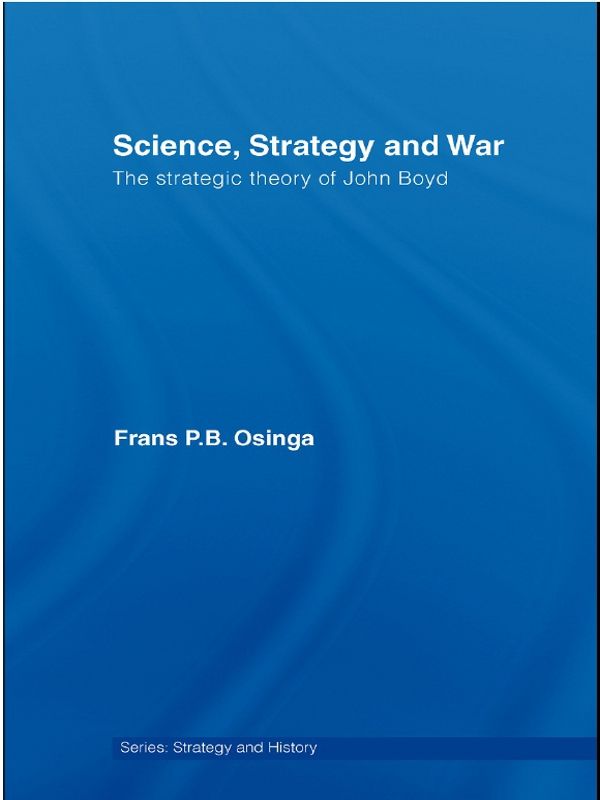York: Bantam Books, 1991 [1975], pp. 56–7. I deliberately refer directly to this book as it is one read by Boyd in the early stages of his research but the issue of determinism is also discussed at length in other books Boyd read.
66 Steven Best and Douglas Kellner, The Postmodern Turn, New York: The Guilford Press, 1997, p. 203.
67 Ibid., p. 202.
68 See Rifkin, op. cit., p. 224; Prigogine and Stengers, op. cit., p. 309; and Murray Gell-Mann, The Quark and the Jaguar, Adventures in the Simple and the Complex, New York: Freeman & Company, 1994, p. 136.
69 Fritjof Capra, The Tao of Physics (Boston: Shambala, 3rd edition, 1991 [1975] [1982], p. 101.
70 At Georgia Tech Boyd had studied James B. Jones and George A. Hawkins, Engineering Thermodynamics (1960), but later works, such as Rifkin’s, take the concept far beyond the realm of engineering.
71 Fritjof Capra, The Turning Point, New York, Bantam Books, 1982, pp. 72–4.
72 Ibid.
73 Capra (1975), op. cit., pp. 61–2.
74 Ibid., p. 81 (note that this work was on Boyd’s early reading lists).
75 Gary Zukav’s, The Dancing Wu Li Masters: An Overview of the New Physics, New York: Bantam, 1979, is one of the books Boyd read that described these developments in detail.
76 Ibid., p. 125.
77 Cited in Capra (1997), op. cit., p. 40.
78 Prigogine and Stengers (1984), op. cit., pp. 222–5.
79 Boyd, Destruction and Creation, p. 10.
80 Jean Piaget, Structuralism, London: Routledge and Kegan Paul, 1971, pp. 32–3.
81 Watson, op. cit., pp. 270–2.
82 Boyd, Destruction and Creation, pp. 8–9.
83 Rifkin mentions Heisenberg and the Second Law in one chapter, but not in all three.
84 Besides the already mentioned early works of Capra, Prigogine, etc., that are listed in the bibliographies of his first papers, his personal papers include a large number of other books on the history of science. Early works include, for instance, George Gamow Thirty Years That Shook Physics, The Story of Quantum Physics (1966) and Werner Heisenberg’s Physics and Philosophy: The Revolution in Modern Science (1962).
85 Fritjof Capra, The Tao of Physics, Boston: Shambala, 3rd edition, 1991, p. 54. The first edition of 1975 already included this passage.
86 Jean Piaget, Structuralism, London: Routledge and Kegan Paul, 1971, p. 44.
87 Ibid., p. 140.
88 Another study on structuralism Boyd had read, Howard Gardner’s The Quest for Mind, Piaget, Levi-Strauss and the Structuralism Movement, Chicago: University of Chicago Press, 1972, actually regards structuralism as the ‘worldview’ that took hold during the 1960s.
89 Capra (1982), op. cit., pp. 77–8.
90 Ludwig von Bertalanffy, op. cit., p. 186.
91 Prigogine and Stengers (1984), op. cit., p. xxix.
92 Uri Merry, Coping With Uncertainty, Insights from the New Sciences of Chaos, Self-Organization, and Complexity, Westport, CT: Preager, 1995, p. 100.
93 Watson, op. cit., p. 757.
94 Capra (1997), op. cit., p. 5; Prigogine and Stengers (1984), op. cit., p. xxvii.
95 Ibid., p. 309.
96 Capra (1997), op. cit., p. 31. A similar discussion can be read in Piaget’s Structuralism.
97 Ibid., pp. 29–35.
98 Bertalanffy, op. cit., p. 19.
99 James Bryant Conant, Two Modes of Thought, New York: Trident Press, 1964, p. 31. This short book includes several examples of scientific breakthroughs in the nineteenth century.
100 Ibid., p. 91.
101 Destruction and Creation; pp. 5–6.
102 The Strategic Game of ? and ?, p. 10.
103 In the bibliography of Destruction and Creation he lists also Maxwell Maltz, Psycho-Cybernetics (1971). The personal papers include U.S. Anderson; Success-Cybernetics: the Practical Application of Human-Cybernetics (1970), F.H. George, Cybernetics (1971) and Y. Sabarina, Cybernetics Within Us (1969), and Marvin Karlins and Lewis Andrews, Biofeedback: Turning on the Power of Your Mind (1973) and Norbert Wiener’s The Human Use of Human Beings: Cybernetics and Society (1967). Chilton Pearce’s works, too, include many references to cybernetics.
104 After Capra (1996), p. 59.
105 Joseph O’Connor and Ian McDermott, The Art of Systems Thinking, San Francisco: Thorsons, 1997, p. 236.
106 Capra (1997), op. cit., pp. 56–64.
107 Ibid., p. 43.
108 Bartallanffy, op. cit., p. 94.
109 Ibid., p. 39.
110 Ibid., p. 141.
111 W. Ross Ashby, An Introduction to Cybernetics, New York: John Wiley & Sons, 1956, pp. 127–31.
112 Bertalanffy, op. cit., p. 150. In popular systems thinking, this feature is enclosed in the notion of feedforward, actions which are the result of expectation and anticipation. See O’Connor and McDermott, op. cit., pp. 48–52.
113 Capra (1997), op. cit., pp. 46–50.
114 Watson, op. cit., pp. 495–6.
115 Ibid., p. 551.
116 Boyd, Patterns of Conflict, p. 128. On p. 159 in Chilton Pearce’s The Crack in the Cosmic Egg Boyd noted that a passage reminded him of his idea of ‘survival on our own terms – capacity for independent action’.
117 Dennis Coon, Essential of Psychology, Pacific Grove, CA: Brookes/Cole, 7th edition, p. 17.
118 Machamer, op. cit., p. 10; and Rick Grush, ‘Cognitive Science’, in Machamer and Silberstein, op. cit., Chapter 13.
119 Adapted from Peter H. Lindsay and Donald A. Norman, Human Information Processing, New York: Academic Press, 1977, p. 689. Similar ones can be found in books Boyd read, such as Daniel Goleman’s Vital Lies, Simple Truths (1985), on pp. 58, 63, 64.
120 O’Connor and McDermott, op. cit., p. 118, and Coon, op. cit., p. 279. See also Gareth Morgan, Images of Organizations, Beverly Hills, CA: Sage, 1986, Chapter 4, in particular pp. 84–97.
121 Ibid., op. cit., p. 119.
122 One very readable account Boyd studied was, for instance, Howard Gardner, The Mind’s New Science, A History of the Cognitive Revolution, New York: Basic Books, 1985. Other works he read that are considered part of the cognitive revolution include John von Neumann, The Computer and the Brain (1958), Norbert Wiener, The Human Use of Human Beings, Cybernetics and Society (1967) and Gilbert Ryle, The Concept of Mind (1966); Richard Restak,





